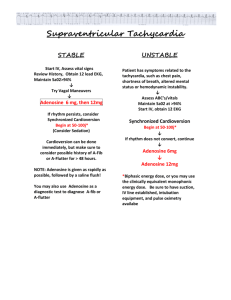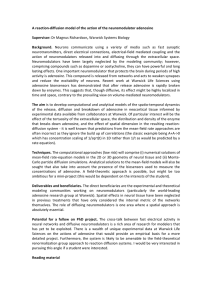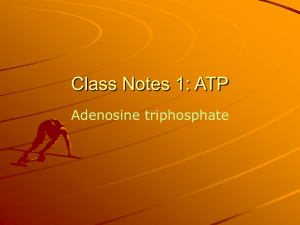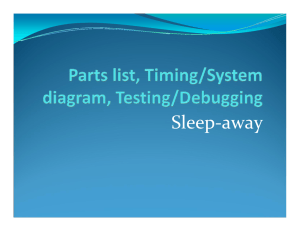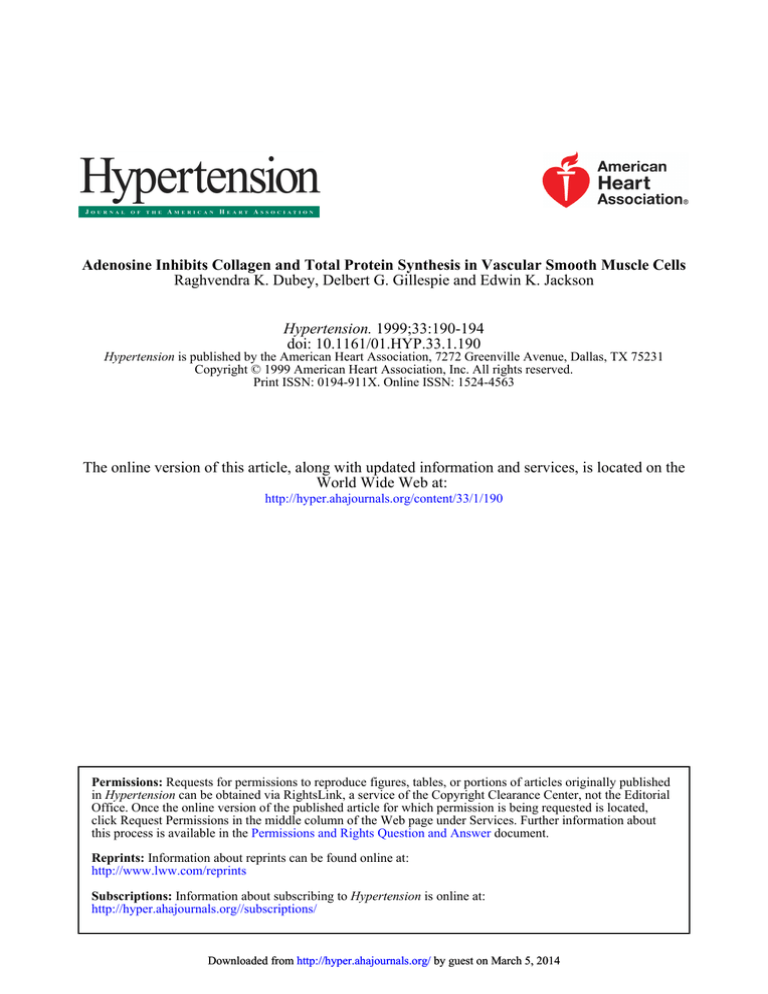
Adenosine Inhibits Collagen and Total Protein Synthesis in Vascular Smooth Muscle Cells
Raghvendra K. Dubey, Delbert G. Gillespie and Edwin K. Jackson
Hypertension. 1999;33:190-194
doi: 10.1161/01.HYP.33.1.190
Hypertension is published by the American Heart Association, 7272 Greenville Avenue, Dallas, TX 75231
Copyright © 1999 American Heart Association, Inc. All rights reserved.
Print ISSN: 0194-911X. Online ISSN: 1524-4563
The online version of this article, along with updated information and services, is located on the
World Wide Web at:
http://hyper.ahajournals.org/content/33/1/190
Permissions: Requests for permissions to reproduce figures, tables, or portions of articles originally published
in Hypertension can be obtained via RightsLink, a service of the Copyright Clearance Center, not the Editorial
Office. Once the online version of the published article for which permission is being requested is located,
click Request Permissions in the middle column of the Web page under Services. Further information about
this process is available in the Permissions and Rights Question and Answer document.
Reprints: Information about reprints can be found online at:
http://www.lww.com/reprints
Subscriptions: Information about subscribing to Hypertension is online at:
http://hyper.ahajournals.org//subscriptions/
Downloaded from http://hyper.ahajournals.org/ by guest on March 5, 2014
Adenosine Inhibits Collagen and Total Protein Synthesis in
Vascular Smooth Muscle Cells
Raghvendra K. Dubey, Delbert G. Gillespie, Edwin K. Jackson
Abstract—The objective of this study was to characterize the effects of exogenous, drug-induced and cAMP-adenosine
pathway– derived adenosine on collagen synthesis by and hypertrophy of vascular smooth muscle cells (SMCs).
Confluent vascular SMCs were stimulated with 2.5% fetal calf serum in the presence and absence of adenosine receptor
agonists [adenosine, 2-chloroadenosine, N6-cyclopentyladenosine, 59-N-ethylcarboxamidoadenosine, 59-N-methylcarboxamidoadenosine, and 2-p-(2-carboxyethyl)phenethylamino-59-N-ethylcarboxamino adenosine], drugs that increase
levels of endogenous adenosine [erythro-9-(2-hydroxy-3-nonyl) adenine, dipyridamole, and iodotubericidin], and cAMP
(increases adenosine by conversion to AMP and hence to adenosine via the cAMP-adenosine pathway). Adenosine
receptor agonists inhibited fetal calf serum-induced collagen and total protein synthesis (as assessed by [3H]proline and
[3H]leucine incorporation, respectively) with a relative potency profile consistent with the effects being mediated by
adenosine A2B receptors. Erythro-9-(2-hydroxy-3-nonyl) adenine, dipyridamole, iodotubericidin, and cAMP also
inhibited collagen and total protein synthesis. The effects of 2-chloroadenosine, erythro-9-(2-hydroxy-3-nonyl) adenine,
iodotubericidin, and cAMP on collagen and total protein synthesis were attenuated by KF17837 and 1,3-dipropyl-8p-sulfophenylxanthine (selective and nonselective A2 receptor antagonists, respectively) but not by 8-cyclopentyl-1,3dipropylxanthine (selective A1 receptor antagonist). These studies indicate that exogenous, drug-induced and
cAMP-adenosine pathway– derived adenosine inhibit vascular SMC collagen synthesis and hypertrophy via A2B
receptors. Thus, exogenous A2B receptor agonists and drugs that modulate endogenous adenosine levels may protect
against vasoocclusive disorders by attenuating extracellular matrix synthesis by and cellular hypertrophy of vascular
SMCs. Moreover, the cAMP-adenosine pathway may protect against vascular hypertrophy. (Hypertension.
1999;33[part II]:190-194.)
Key Words: adenosine n muscle, smooth n extracellular matrix n collagen n hypertrophy
W
e recently showed that exogenous and endogenous
adenosine inhibits fetal calf serum-induced proliferation of vascular smooth muscle cells (SMCs).1,2 Because
many factors that induce or inhibit vascular SMC proliferation also affect vascular SMC hypertrophy and extracellular
matrix synthesis, we hypothesized that adenosine receptor
agonists and drugs that increase endogenous levels of adenosine may have pharmacotherapeutic potential as inhibitors
of vascular SMC hypertrophy and extracellular matrix synthesis. In support of this hypothesis, we reported that exogenous and endogenous adenosine inhibits collagen biosynthesis in human vascular SMCs.3 However, whether adenosine
receptor agonists and drugs that increase endogenous adenosine alter vascular SMC hypertrophy and, if so, what adenosine receptor subtypes are involved are unanswered questions
that are addressed in the present study.
Stimulation of adenylyl cyclase leads to cAMP egress
which can be metabolized to AMP and hence to adenosine on
the cell surface by the enzymes ecto-59-nucleotidase and
ectophosphodiesterase, respectively (ie, the cAMP-adenosine
pathway), thus providing high local concentrations of adenosine that importantly might contribute to the regulation of
vascular SMC growth4 and nitric oxide production.5 However, whether the cAMP-adenosine pathway might contribute
to the regulation of vascular SMC collagen synthesis and
hypertrophy is unknown, and this hypothesis is also addressed in the current study.
Methods
Adenosine, 2-chloroadenosine (Cl-Ad), cAMP, erythro-9(2-hydroxy-3-nonyl) adenine hydrochloride (EHNA), and dipyridamole (DIP) were purchased from Sigma Chemical
Co. N6-Cyclopentyladenosine (CPA), 2-p-(2-carboxyethyl)
Received September 16, 1998; first decision October 12, 1998; revision accepted October 23, 1998.
Center for Clinical Pharmacology (R.K.D., D.G.G., E.K.J.), Departments of Medicine and Pharmacology (E.K.J.), University of Pittsburgh Medical
Center, Pittsburgh, USA and Clinic for Endocrinology (R.K.D.), Department of Obstetrics and Gynecology, University Hospital Zurich, Zurich,
Switzerland.
Presented at the Annual American Heart Association Meeting for Council for High Blood Pressure, Philadelphia, September 1998, and published in
abstract form (Hypertension, 1998).
Correspondence to Dr Raghvendra K. Dubey, Center for Clinical Pharmacology, 623 Scaife Hall, 200 Lothrop Street, University of Pittsburgh Medical
Center, Pittsburgh, PA 15213-2582, USA. E-mail dubey@novell2.dept-med.pitt.edu
© 1999 American Heart Association, Inc.
Hypertension is available at http://www.hypertensionaha.org
190
Downloaded from http://hyper.ahajournals.org/
by guest on March 5, 2014
Dubey et al
phenethylamino-59-N-ethylcarboxamino adenosine hydrochloride
(CGS21680), 8-cyclopentyl-1,3-dipropylxanthine (DPCPX), iodotubericidin (IDO), 1,3-dipropyl-8-p-sulfophenylxanthine (DPSPX), 59N-ethylcarboxamidoadenosine (NECA), and 59-N-methylcarboxamidoadenosine (MECA) were purchased from Research Biochemicals
International. Dulbecco’s Modified Eagle’s Medium (DMEM),
DMEM/F12 medium, penicillin, streptomycin, 0.25% trypsin-EDTA
solution, and all tissue culture ware were purchased from GIBCO
Laboratories. Fetal calf serum (FCS) was obtained from HyClone
Laboratories Inc. KF17837 was a generous gift from Dr F. Suzuki,
Pharmaceutical Research Laboratories, Kyowa Hakko Kogyo Co,
Ltd, Sunto, Shizuoka, Japan. L-[3H]Proline (specific activity, 23
Ci/mmol) and L-[4,5-3H(N)]leucine (specific activity, 50 Ci/mmol)
were purchased from NEN. All other chemicals used were of tissue
culture or best grade available.
Aortic SMCs were cultured as explants from the abdominal aortas
obtained from ether-anesthetized male Sprague-Dawley rats (Charles
River, Wilmington, Mass), after a midline abdominal incision
including the diaphragm and as described previously by us.1,2
Vascular SMC purity was characterized by immunofluorescence
staining with smooth muscle specific anti-smooth muscle a-actin
monoclonal antibodies and by morphological criteria specific for
smooth muscle as described in detail previously.1,2 Vascular SMCs
were passaged by trypsinization, and cells in 3rd passage were used
for growth studies.
[3H]Proline and [3H]leucine incorporation studies were performed
to investigate the effects of agents on FCS-induced collagen and total
protein synthesis, respectively. Vascular SMCs were plated in
24-well tissue culture dishes and allowed to grow to confluence in
DMEM/F12 containing 10% FCS under standard tissue culture
conditions. Vascular SMCs were made quiescent by incubating in
DMEM containing 0.4% bovine serum albumin for 48 hours.
Collagen and protein synthesis were initiated by incubating growtharrested vascular SMCs for 36 and 25 hours, respectively, with
DMEM supplemented with 2.5% FCS and with or without adenosine
receptor agonists, modulators of adenosine levels, cAMP, adenosine
receptor antagonists, and/or enzyme inhibitors. For collagen synthesis the cells were treated for 36 hours in the presence of L-[3H]proline
(1 mCi/mL); whereas, for total protein synthesis after 20 hours of
treatment, the cells were pulsed for 5 hours with L-[3H]leucine (1
mCi/mL). The experiments were terminated by washing the cells
twice with Dulbecco’s PBS and twice with ice-cold trichloroacetic
acid (10%). The precipitate was solubilized in 500 mL of 0.3 N
NaOH and 0.1% SDS after incubation at 50°C for 2 hours. Aliquots
from 4 wells for each treatment with 10 mL scintillation fluid were
counted in a liquid scintillation counter.
All experiments were conducted in confluent monolayers of cells
in which changes in cell number were precluded. Additionally, cell
counting was performed in cells treated in parallel to the cells used
for the collagen and total protein synthesis studies, and the data were
normalized to cell number. Experiments were performed in quadruplicate with 3 to 6 separate cultures, and the data are presented as
mean6SEM. Statistical analysis was performed by ANOVA, paired
Students’ t test, and Fisher’s least significant difference test as
appropriate. A value of P,0.05 was considered statistically
significant.
Results
Adenosine and Cl-Ad (a metabolically stable adenosine
analog) inhibited proline and leucine incorporation in a
concentration-dependent manner (Figure 1; P,0.05). The
threshold concentration for inhibition of proline and
leucine incorporation was 10 nmol/L for adenosine and 0.1
nmol/L for Cl-Ad. Cl-Ad (IC50 values of 10 and 4 mmol/L
for inhibition of proline and leucine incorporation, respectively) was more potent than adenosine (IC 50 of
100 mmol/L for inhibition of both proline and leucine
incorporation). CGS21680, an adenosine agonist selective
for A2A receptors,6 had little effect on proline or leucine
January 1999 Part II
191
Figure 1. Inhibition of proline and leucine incorporation by
adenosine, Cl-Ad, CPA, CGS21680, NECA, and MECA in vascular SMCs. Results are expressed as percent of control incorporation, where 100% is leucine or proline incorporation/106 cells
in response to 2.5% FCS. Values are mean6SEM (3 experiments in quadruplicate). * indicates a significant (P,0.05) effect
on proline or leucine incorporation. The inhibitory effects of
Cl-Ad and MECA were significantly different (P,0.05) than all
other agonists.
incorporation (Figure 1). High (.1026 to 1024 mol/L), but
not low, concentrations of CPA, a selective A1 adenosine
receptor agonist, inhibited proline and leucine incorporation (Figure 1). NECA, an adenosine agonist which has
equal affinity for both A1 and A2 receptors,6 was more
potent than CPA, but less potent than Cl-Ad in inhibiting
proline and leucine incorporation (Figure 1). MECA,
which has greater affinity for A2 than A1 receptors,6 was
more potent than NECA, CPA, and CGS (Figure 1) and
as potent as Cl-Ad in inhibiting proline and leucine
incorporation (Figure 1). Thus, the order of potency for
inhibition of proline and leucine incorporation was
Cl-Ad5MECA.NECA5adenosine.CPA.CGS21680
(Figure l).
EHNA, DIP, and IDO, which elevate endogenous levels of
adenosine by inhibiting adenosine deaminase,6 blocking nucleoside transport,6 and inhibiting adenosine kinase,6 respectively, inhibited proline and leucine incorporation in a
concentration-dependent manner (P,0.001; Figure 2).
Threshold concentrations for inhibition of both proline and
leucine incorporation were 10, 0.01, and 0.01 mmol/L for
EHNA, DIP, and IDO, respectively. IC50 values for inhibition
of proline incorporation by EHNA, DIP, and IDO were 50, 5,
and 5 mmol/L, respectively, and for inhibition of leucine
incorporation were 50, 1, and 1 mmol/L, respectively.
To assess whether metabolism of adenosine was responsible for the decreased potency of adenosine relative to Cl-Ad,
we studied the effects of adenosine on proline and leucine
incorporation in the presence and absence of EHNA, IDO,
and EHNA plus IDO. As shown in Figure 3, the inhibitory
effects of adenosine1EHNA, adenosine1IDO, and adenosine1IDO1EHNA on proline and leucine incorporation
were significantly greater than adenosine per se. Moreover, in
vascular SMCs treated with adenosine1EHNA1IDO, proline, and leucine incorporation were reduced to almost basal
levels.
Downloaded from http://hyper.ahajournals.org/ by guest on March 5, 2014
192
Adenosine Inhibits SMC Matrix Protein Synthesis
Figure 4. Inhibitory effects of Cl-Ad (10 mmol/L) and cAMP
(10 mmol/L) on proline and leucine incorporation in presence
and absence of KF17837 (1029 mol/L), DPSPX (1028 mol/L), and
DPCPX (1028 mol/L). Results are expressed as percent of control incorporation, where 100% is leucine or proline incorporation/106 cells in response to 2.5% FCS. Values are mean6SEM
(3 experiments in quadruplicate). *P,0.01 versus control;
§P,0.05 versus Cl-Ad.
Figure 2. Inhibition of proline and leucine incorporation by
EHNA, IDO, and DIP. Results are expressed as percent of control incorporation, where 100% is leucine or proline incorporation/106 cells in response to 2.5% FCS. Values are mean6SEM
(3 experiments in quadruplicate). *P,0.05 versus control.
To further evaluate the role of adenosine receptors in
mediating the inhibitory effects of adenosine, experiments
were conducted with use of the adenosine receptor antagonists DPCPX, DPSPX, and KF17837, which inhibit the
effects of adenosine by blocking A1, A1 plus A2, and A2
receptors, respectively.6 DPSPX (1028 mol/L) and KF17837
(1029 mol/L), but not DPCPX (1028 mol/L), significantly
attenuated the inhibitory effects of Cl-Ad (10 mmol/L) on
proline and leucine incorporation (Figure 4). Like Cl-AD,
cAMP, a putative precursor of adenosine, also attenuated
proline and leucine incorporation and this effect was antagonized by DPSPX and KF17837, but not DPCPX (Figure 4).
The inhibitory effects of EHNA (10 mmol/L) and IDO
(0.1 mmol/L) on proline and leucine incorporation were also
significantly attenuated by DPSPX and KF17837, but not by
DPCPX (Figure 5).
Trypan blue exclusion tests were conducted in parallel to
confirm that cell death did not contribute to the observed
inhibitory effects of the various treatments. Moreover cells in
the supernatant were counted to confirm that loss of cells by
detachment did not occur during these treatments. At the
concentrations used in this study, no loss in cell viability was
observed in cells treated with adenosine, CPA, CGS21680,
MECA, NECA, DPSPX, KF17837, or DPCPX. The highest
concentrations of Cl-Ad (1 mmol/L), EHNA (100 mmol/L),
DIP (100 mmol/L), and IDO (100 mmol/L) did decrease cell
viability by approximately 7%, but not cell number. No
floating cells were present in the supernatant, and the cell
number in the well surface was not significantly different in
controls and treated wells.
Discussion
The results of the present study demonstrate that treatment of
rat aortic SMCs with adenosine or a stable adenosine analog
Figure 3. Effects of combinations of EHNA (10 mmol/L), IDO
(0.1 mmol/L), and adenosine (1 mmol/L) on proline and leucine
incorporation, where 100% is leucine or proline incorporation/
106 cells in response to 2.5% FCS. Results are expressed as
percent of control incorporation. Values are mean6SEM (3
experiments in quadruplicate). *P,0.05 versus control; §P,0.05
versus no EHNA, no IDO, or EHNA plus IDO.
Figure 5. Effects of KF17837 (1029 mol/L), DPSPX (1028 mol/L),
and DPCPX (1028 mol/L) on EHNA and IDO induced inhibition of
proline and leucine incorporation. Results are expressed as percent of control incorporation, where 100% is leucine or proline
incorporation/106 cells in response to 2.5% FCS. Values are
mean6SEM (3 experiments in quadruplicate). *P,0.05 versus
control; §P,0.05 versus EHNA.
Downloaded from http://hyper.ahajournals.org/ by guest on March 5, 2014
Dubey et al
(Cl-Ad) inhibited FCS-induced collagen as well as total
protein synthesis. The inhibitory effects of adenosine were
fully mimicked by MECA, an adenosine agonist with high
affinity for A2 receptors,6,7 and partially by NECA, an
adenosine agonist with equal affinity for both A1 and A2
receptors,6,7 but not by the adenosine agonists CPA and
CGS21680, which are selective A1 and A2A receptor agonists,6,7 respectively. Thus the inhibitory effects of adenosine
are likely mediated via A2B receptors and not via A1 or A2A
receptors.
Our conclusion that the inhibitory effects of adenosine
are mediated via A2B receptors is supported further by the
recently proposed subclassification of A2A and A2B receptors. Gurden et al8 demonstrated that the relative potencies
of CGS21680 and NECA can be used as a reference to
differentiate A2B from A2A. When the effects of CGS21680
are as potent as NECA, this implicates the A2A receptor.
However, when CGS21680 is less potent than NECA, this
indicates that the observed effects are mediated via activation of the A2B receptor. In the present study, compared
with CGS21680, NECA was more effective in mimicking
the inhibitory effects of adenosine, which further substantiates our conclusion that the inhibitory effects of adenosine are mediated via A2B receptors. Also consistent with
this conclusion are the observations that the inhibitory
effects of Cl-Ad were significantly reversed by KF17837,
a selective A2 receptor antagonist,6,7 and by DPSPX, a
nonselective A2 receptor antagonist,6,7 but not by DPCPX,
a selective A1 receptor antagonist.6,7
The above-mentioned findings provide the first evidence
that exogenous adenosine inhibits FCS-induced collagen and
protein synthesis in rat vascular SMCs and that the inhibitory
effects of adenosine are mediated via activation of A2B
receptors. However, whether endogenous adenosine has similar inhibitory effects cannot be inferred from studies with
agonists. Hence, we examined the inhibitory effects of agents
that elevate cellular adenosine levels via different mechanisms to assess the role of endogenous, ie, vascular SMCderived, adenosine on FCS-induced synthesis of collagen and
protein in vascular SMCs.
The physiological effects of adenosine are governed
partly by the rapid rate of elimination of adenosine from
the extracellular space. Elimination of adenosine from the
interstitial space is mediated by facilitated transport of
adenosine into cells and also by the metabolism of adenosine to inosine by adenosine deaminase9 and to adenosine
monophosphate by adenosine kinase.9 Inhibition of the
enzyme adenosine deaminase by EHNA and the enzyme
adenosine kinase by IDO, as well as the inhibition of
adenosine transport and metabolism by DIP, has been
shown to increase endogenous levels of adenosine.6,9
Hence, these three compounds were used in the present
study to increase endogenous levels of adenosine to
evaluate the effects of endogenously generated adenosine
on FCS-induced collagen and protein synthesis.
EHNA and IDO inhibited collagen and protein synthesis, and KF17837, a selective A2 adenosine receptor
antagonist,6 and DPSPX, a nonselective A2 receptor antagonist,6 significantly reversed the inhibitory effects of
January 1999 Part II
193
EHNA and IDO. The inhibitory effects of EHNA, IDO,
and DIP also were significantly enhanced when vascular
SMCs were treated with a combination of these agents.
These findings support our contention that the inhibitory
effects of these agents on collagen and protein synthesis in
vascular SMCs are mediated via generation of adenosine.
Moreover, the finding that DPCPX, a selective A1 receptor
antagonist, did not reverse the inhibitory effects of EHNA
and IDO on vascular SMCs strongly suggests that the
inhibitory effects of endogenous adenosine are mediated
via A2 receptors.
An important pathway by which adenosine is formed at
the vascular SMC surface and within and/or near the blood
vessel wall is the cAMP-adenosine pathway.4,5 Adenosine
production in vascular SMCs via this pathway would be
more amenable to physiological modulation by hormones.
In this regard, stimulation of adenylyl cyclase results in
egress of cAMP,4,9 and relatively modest increases in
cAMP production could give rise to significant concentrations of adenosine at the cell surface, because adenosine
would be synthesized by a series of spatially linked
enzymatic reactions.4,9 We recently showed that the inhibitory effects of cAMP on vascular SMC proliferation are
blocked by A2 adenosine receptor antagonists,4 thus implying that the cAMP-adenosine pathway regulates vascular SMC growth. Because cAMP is a precursor for adenosine 4,5 and adenosine inhibits mitogen-induced cell
growth, we hypothesized that the cAMP-adenosine pathway may be a potential pathway regulating collagen and
total protein synthesis in vascular SMCs. To test this
hypothesis, we evaluated the effects of cAMP on FCSinduced collagen and protein synthesis in the presence and
absence of the A2-specific and nonspecific receptor antagonists, KF17837 and DPSPX, respectively, and the A1
adenosine receptor antagonist, DPCPX. Exogenous cAMP
inhibited FCS-induced collagen and protein synthesis in
vascular SMCs, and the inhibitory effects of cAMP on
collagen and protein synthesis were significantly attenuated by the adenosine receptor antagonists KF17837 and
DPSPX, but not by DPCPX, which suggests the involvement of A2 receptors. This conclusion is consistent with
our observations that the inhibitory effects of exogenous
and endogenous adenosine on collagen and protein synthesis in vascular SMCs are mediated via A2 receptors and are
blocked by KF17837 and DPSPX.
In conclusion we provide evidence that both exogenous
and vascular SMC-derived adenosine inhibits FCSinduced collagen and total protein synthesis by vascular
SMCs. Thus, our findings suggest that adenosine produced
by vascular SMCs may play a vital role as a local
inhibitory agent regulating vascular hypertrophy. Moreover, decreased synthesis of adenosine by vascular SMCs
or increased catabolism of adenosine by adenosine deaminase or adenosine kinase may contribute importantly to the
abnormal synthesis and deposition of collagen and hypertrophy of vascular SMCs observed in vasoocclusive disorders associated with hypertension, atherosclerosis, and
restenosis. Agents that elevate endogenous adenosine
could be clinically important in preventing neointima
Downloaded from http://hyper.ahajournals.org/ by guest on March 5, 2014
194
Adenosine Inhibits SMC Matrix Protein Synthesis
formation by inhibiting extracellular matrix synthesis and
deposition by vascular SMCs, thus exerting beneficial
effects on the vascular structure.
Acknowledgments
This work was supported by grants from the National Institutes of
Health (HL 55314 and HL 35909) and the Swiss National Science
Foundation (32-54172.98).
References
1. Dubey RK, Gillespie DG, Mi Z, Suzuki F, Jackson EK. Smooth muscle
cell-derived adenosine inhibits cell growth. Hypertension. 1996;27
[part 2]:766 –773.
2. Dubey RK, Gillespie DG, Osaka K, Suzuki F, Jackson EK. Adenosine
inhibits growth of rat aortic smooth muscle cells. Possible role of A2b
receptor. Hypertension. 1996;27 [part 2]:786 –793.
3. Dubey RK, Gillespie DG, Mi Z, Jackson EK. Adenosine inhibits growth
of human aortic smooth muscle cells via A2B receptors. Hypertension.
1998;31:516 –521.
4. Dubey RK, Mi Z, Gillespie DG, Jackson EK. Cyclic AMP-Adenosine
pathway inhibits vascular smooth muscle cell growth. Hypertension.
1996;28:765–771.
5. Dubey RK, Gillespie DG, Jackson EK. Cyclic-AMP-adenosine pathway
induces nitric oxide synthesis in aortic smooth muscle cells. Hypertension. 1998;31 [part 2]:296 –302.
6. Dubey RK, Gillespie DG, Mi Z., Jackson EK. Exogenous and endogenous adenosine inhibits fetal calf serum-induced growth of rat
cardiac fibroblasts: Role of A 2B receptors. Circulation. 1997;96:
2656 –2666.
7. Dalziel HH, Westfall DP. Receptors for adenine nucleotides and nucleosides: subclassification, distribution, and molecular characterization.
Pharmacol Rev. 1994;46:449 – 462.
8. Gurden, MF, Coates J, Ellis F, Evans B, Foster M, Hornby E, Kennedy
I, Martin DP, Strong P, Vardey CJ, Wheeldon A. Functional characterization of three adenosine receptor types. Br J Pharmacol. 1993;109:
693– 698.
9. Jackson EK, Koehler M, Mi Z, Dubey RK, Tofovic SP, Carcillo JA, Jones
GS. Possible role of adenosine deaminase in vaso-occlusive diseases. J
Hypertens. 1996;14:19 –29.
Downloaded from http://hyper.ahajournals.org/ by guest on March 5, 2014

